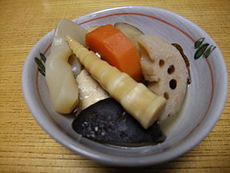| This article needs additional citations for verification. Please help improve this article by adding citations to reliable sources. Unsourced material may be challenged and removed. Find sources: "Nimono" – news · newspapers · books · scholar · JSTOR (January 2018) (Learn how and when to remove this message) |
 Nishime, a nimono of various vegetables (including bamboo shoot, lotus root and shiitake) prepared in southern Aomori Prefecture Nishime, a nimono of various vegetables (including bamboo shoot, lotus root and shiitake) prepared in southern Aomori Prefecture | |
| Course | Side dish |
|---|---|
| Place of origin | Japan |
| Region or state | Japanese-speaking areas |
| Main ingredients | Vegetable or seafood, dashi, sake, soy sauce, mirin |
| Similar dishes | Jorim |

Nimono (煮物) is a simmered dish in Japanese cuisine. A nimono generally consists of a base ingredient simmered in shiru stock and seasoned with sake, soy sauce, and a small amount of sweetening. The nimono is simmered in the shiru over a period of time until the liquid is absorbed into the base ingredient or evaporated. The base ingredient for a nimono is typically a vegetable, fish, seafood, or tofu, or some combination of these. The shiru stock for a nimono is generally dashi. Other than sake and soy sauce, the stock can be further flavored with mirin, sugar, salt, vinegar, miso, or other condiments.
Types

- Misoni (味噌煮), also misodaki (味噌炊き): fish, but sometimes vegetables, simmered in a mixture of miso and dashi
- Nikujaga (肉じゃが): beef and potato stew, flavoured with sweet soy
- Nizakana (煮魚): fish poached in a broth of sweetened dashi, sometimes with miso, also referred to as nitsuke (煮付け). The dish first appears in cookbooks in the early 18th century
- Kakuni (角煮): chunks of pork belly stewed in soy, mirin and sake with large pieces of daikon and whole boiled eggs. The Okinawan variation, using awamori, soy sauce and miso, is known as rafuti.
- Sōki (ソーキ): Okinawan dish of pork stewed with bone
- Nabemono (鍋物): one pot
- Nishime (煮染め): simmered vegetables (i.e. carrots, taros, lotus root, konnyaku, etc.), simmered-down in soy sauce and water until the liquid is almost gone, almost to dryness.
See also
References
- "味噌煮" [Misoni]. Nihon Kokugo Daijiten (in Japanese). Tokyo: Shogakukan. 2012. OCLC 56431036. Archived from the original on 2007-08-25. Retrieved 2012-06-27.
- "煮魚" [Nizakana]. Nihon Kokugo Daijiten (in Japanese). Tokyo: Shogakukan. 2012. OCLC 56431036. Archived from the original on 2007-08-25. Retrieved 2012-06-27.
Bibliography
- Hosking, Richard (2000). At the Japanese Table. Images of Asia. New York: Oxford University Press. ISBN 978-0-195-90980-7. LCCN 00058458. OCLC 44579064.
- Ashkenazi, Michael; Jacob, Jeanne (2000). The Essence Of Japanese Cuisine: an Essay On Food And Culture. Richmond, Surrey: Curzon. ISBN 978-0-700-71085-0. OCLC 44937736.